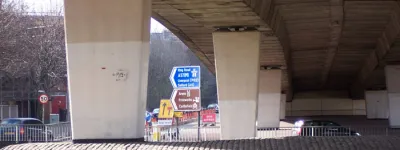How do you describe the type or cross-section of a road? One way is to use these engineering abbreviations, much loved by the UK's community of road enthusiasts.
Terms like S2 and D3M are simple enough if you understand them, but newcomers can understandably be bewildered by the various abbreviations that are discussed. The following are mostly terms used in highway engineering and appear in government design standards such as the Design Manual for Roads and Bridges (DMRB). Some are adaptations or extensions to the system created by users of the SABRE forums.
The abbreviations are all ways of describing the width of a road and the way its surface is marked out for traffic. They are an informal shorthand and not always completely logical.
Definitions of other terms are in the Dictionary.
Single carriageway roads
Single carriageways (roads with one paved surface) are described by the letter S, followed by the total number of lanes.
S2
A standard two lane road. Usually that means one lane each way, though the term describes only the physical characteristics of the road, so it could just as easily be a one-way road with two lanes travelling in the same direction.
WS2
Wider than usual two lane road. New rural trunk roads are sometimes built to this standard, which was particularly common in the 1980s and 90s. It permits overtaking without vehicles having to fully cross into a lane of oncoming traffic.
S3
A single carriageway road divided into three lanes, with the centre lane intended for overtaking, but with neither direction having priority in using it. This was common on rural trunk roads from the 1930s through to the 1970s, but few examples survive. Most have been re-marked as WS2.
S2+1
A three-lane road where the one direction takes two lanes and the other takes one. The same physical width could be laid out as WS2+1, meaning three lanes, with the middle lane switching direction every so often to provide an overtaking lane to each side in turn.
S4
A four lane road with two lanes each way. It does not qualify as a dual carriageway as there is no physical divide between the two directions of flow. These may be divided by double-white lines to prevent vehicles crossing, but in practice there is often a dashed white line down the middle, meaning that vehicles could theoretically overtake in both lanes of oncoming traffic.
Dual carriageway roads
Dual carriageways (roads with two paved surfaces side by side) are described by the letter D, followed by the number of lanes on one side.
D2
A dual carriageway with two lanes each way, making a total of four lanes open to traffic. The paved width extends only to the width of the traffic lanes. Urban roads might be to this standard, or older rural roads.
D2H
A dual carriageway with two lanes each way, that is also equipped with hard strips. This standard is commonly used for rural non-motorway dual carriageways, with the one metre wide hard strips providing a buffer between fast-moving traffic and the verge.
D3M
A dual carriageway with three lanes each way, equipped with full hard shoulders. The 'M' refers to the fact that this is a motorway formation, but a non-motorway road could be built this way too, and indeed some are. The 'M' does not indicate the presence of motorway regulations.
